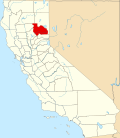2020
Greenville CDP, California – Racial and ethnic composition
Note: the US Census treats Hispanic/Latino as an ethnic category. This table excludes Latinos from the racial categories and assigns them to a separate category. Hispanics/Latinos may be of any race.| Race / Ethnicity (NH = Non-Hispanic) | Pop 2000 [34] | Pop 2010 [35] | Pop 2020 [36] | % 2000 | % 2010 | % 2020 |
|---|
| White alone (NH) | 933 | 830 | 752 | 80.43% | 73.52% | 73.29% |
| Black or African American alone (NH) | 1 | 0 | 7 | 0.09% | 0.00% | 0.68% |
| Native American or Alaska Native alone (NH) | 83 | 118 | 90 | 7.16% | 10.45% | 8.77% |
| Asian alone (NH) | 3 | 11 | 2 | 0.26% | 0.97% | 0.19% |
| Native Hawaiian or Pacific Islander alone (NH) | 0 | 0 | 1 | 0.00% | 0.00% | 0.10% |
| Other race alone (NH) | 1 | 0 | 9 | 0.09% | 0.00% | 0.88% |
| Mixed race or Multiracial (NH) | 31 | 61 | 76 | 2.67% | 5.40% | 7.41% |
| Hispanic or Latino (any race) | 108 | 109 | 89 | 9.31% | 9.65% | 8.67% |
| Total | 1,160 | 1,129 | 1,026 | 100.00% | 100.00% | 100.00% |
The 2020 United States census reported that Greenville had a population of 1,026. The population density was 128.4 inhabitants per square mile (49.6/km2). The racial makeup of Greenville was 783 (76.3%) White, 7 (0.7%) African American, 97 (9.5%) Native American, 2 (0.2%) Asian, 1 (0.1%) Pacific Islander, 31 (3.0%) from other races, and 105 (10.2%) from two or more races. Hispanic or Latino of any race were 89 persons (8.7%). [37]
The whole population lived in households. There were 491 households, out of which 118 (24.0%) had children under the age of 18 living in them, 164 (33.4%) were married-couple households, 52 (10.6%) were cohabiting couple households, 138 (28.1%) had a female householder with no partner present, and 137 (27.9%) had a male householder with no partner present. 170 households (34.6%) were one person, and 93 (18.9%) were one person aged 65 or older. The average household size was 2.09. [37] There were 261 families (53.2% of all households). [38]
The age distribution was 178 people (17.3%) under the age of 18, 65 people (6.3%) aged 18 to 24, 229 people (22.3%) aged 25 to 44, 281 people (27.4%) aged 45 to 64, and 273 people (26.6%) who were 65 years of age or older. The median age was 48.5 years. For every 100 females, there were 102.4 males. [37]
There were 595 housing units at an average density of 74.4 units per square mile (28.7 units/km2), of which 491 (82.5%) were occupied. Of these, 265 (54.0%) were owner-occupied, and 226 (46.0%) were occupied by renters. [37]
2010
At the 2010 census Greenville had a population of 1,129. The population density was 141.3 inhabitants per square mile (54.6/km2). The racial makeup of Greenville was 897 (79.5%) White, Hispanic or Latino of any race were 109 people (9.7%), 1 (0.1%) African American, 133 (11.8%) Native American, 11 (1.0%) Asian, 0 (0.0%) Pacific Islander, 17 (1.5%) from other races, and 70 (6.2%) from two or more races. [39]
The whole population lived in households, no one lived in non-institutionalized group quarters and no one was institutionalized.
There were 496 households, 139 (28.0%) had children under the age of 18 living in them, 181 (36.5%) were opposite-sex married couples living together, 77 (15.5%) had a female householder with no husband present, 25 (5.0%) had a male householder with no wife present. There were 52 (10.5%) unmarried opposite-sex partnerships, and 3 (0.6%) same-sex married couples or partnerships. 171 households (34.5%) were one person and 67 (13.5%) had someone living alone who was 65 or older. The average household size was 2.28. There were 283 families (57.1% of households); the average family size was 2.91.
The age distribution was 256 people (22.7%) under the age of 18, 78 people (6.9%) aged 18 to 24, 227 people (20.1%) aged 25 to 44, 378 people (33.5%) aged 45 to 64, and 190 people (16.8%) who were 65 or older. The median age was 45.4 years. For every 100 females, there were 97.4 males. For every 100 females age 18 and over, there were 95.3 males.
There were 613 housing units at an average density of 76.7 per square mile, of the occupied units 251 (50.6%) were owner-occupied and 245 (49.4%) were rented. The homeowner vacancy rate was 4.9%; the rental vacancy rate was 9.2%. 583 people (51.6% of the population) lived in owner-occupied housing units and 546 people (48.4%) lived in rental housing units.



